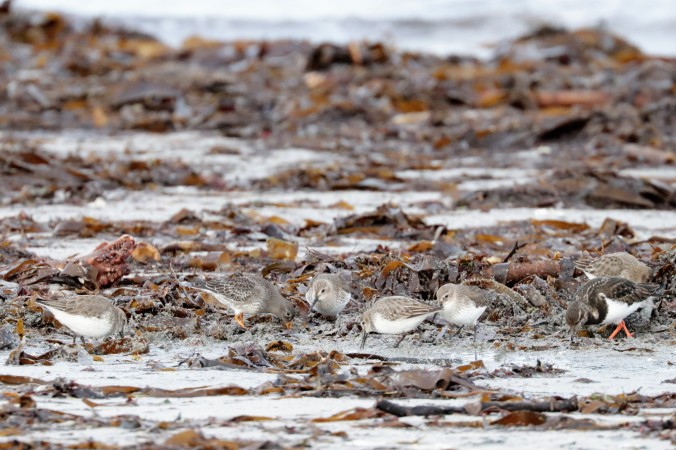We spent January 2019 in the small town of Pennan in the north of Aberdeenshire. Not necessarily a “mark your calendar”-month for birding, but January still offers some interesting encounters.
Places
Pretty much anywhere along the coast can be great to see sea ducks such as eider or scoters, and the inland fields are often good for wintering geese. There are a few areas, though, which stood out:
Rosehearty beach was our favorite place to watch waders. The beach there was regulary full of dunlin, redshank, turnstone, ringed plovers, purple sandpipers, and once also a lonely bar-tailed godwit.

The RSPB site Loch of Strathbeg is simply a place of tranquility. There’s plenty of water fowl, but also a good place to see hen harrier or whooper swans.
The RSPB site Troup Head has a name for hosting the largest gannetry on the British mainland (the largest overall being Bass Rock). Fulmar start occupying cliff sites in January, and gannets start returning to the cliffs towards end of January. We visited a few times, and while the area was beautiful to visit and very peaceful, in terms of birding it was rather uneventful. (The RSPB website states for autumn: Enjoy the peace as the birds depart for the winter. And for winter: Look out for the first gannets and fulmars returning in mid-January. Now you know when to visit.)
Some further areas which could be interesting, but which we found to be pretty quiet in January:
- Burghead
- Findhorn Bay (has a big name, but having visited twice, we only ever saw very distant waders, and a few commoners like redshank or wigeon)
- Spey Bay (again, well-known, and yet we found it to be rather quiet)
Commoners
Visiting another country always brings with it the nice experience of re-visiting the notion of what is common and what is rare. Some birds we were very happy to see and have rarely or never seen in Switzerland:
And yet all of these are common birds in Aberdeenshire. Godwits spend the winter in the UK, with highest numbers between November and February. Long-tailed ducks are commonly seen off the coast, arriving at UK coast after October, and leaving around March. Pink-footed geese spend about the same time-frame in the UK and can be seen in flocks of thousands grazing the fields.
Noteworthy
Among the rather common of the noteworthy were the red-throated divers, occasionally seen off the coast. Around March or April they’ll start moving inland a bit to look for suitable breeding areas at freshwater lochs.

A species which used to be abundant in the UK, but now brings a smile to most birders is the corn bunting. One of those plentiful victims of habitat loss, they are still fairly often seen at the RSPB site Loch of Strathbeg.

Having seen pink-footed geese for the first time during this trip, we would have never been able to distinguish the taiga bean goose from its similar-looking relative. This individual stayed at RSPB Loch of Strathbeg for a few days and was most likely the main attraction.

Finally, the bird which is only recorded a handful of times per year. The bird which the local recorded found most noteworthy in our observation list. The black redstart. A beautiful example that what is locally seen as “common” might be rare somewhere else, and that really each bird and each species deserves appreciation.











